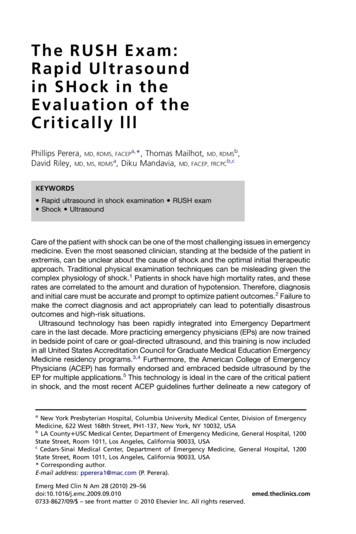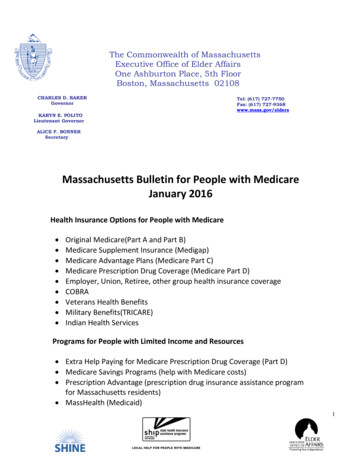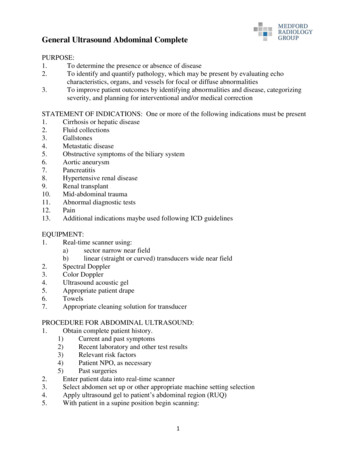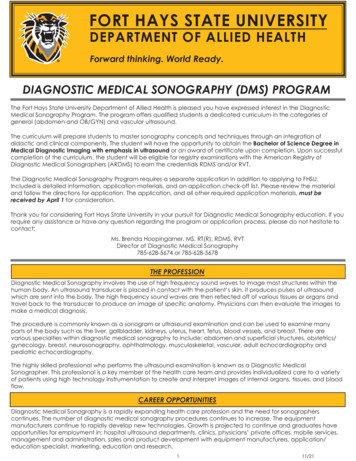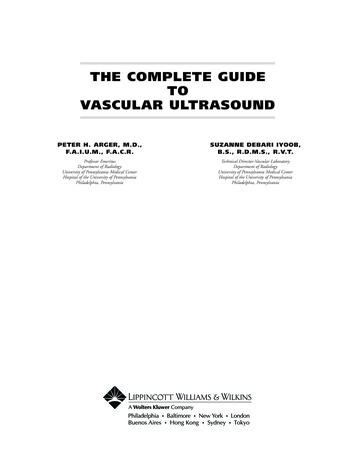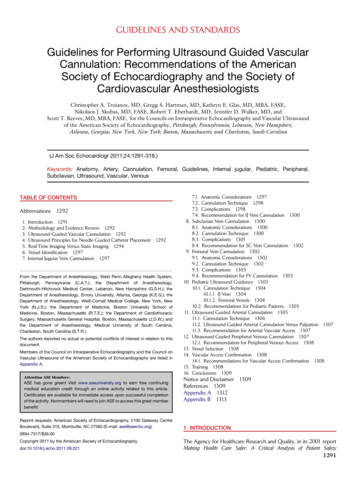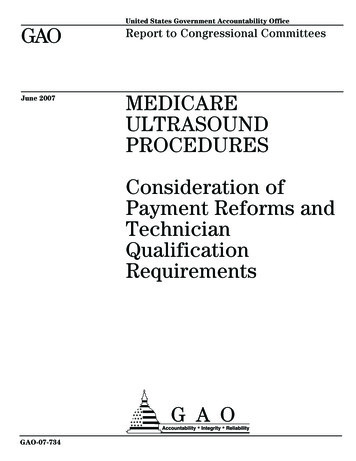
Transcription
United States Government Accountability OfficeGAOReport to Congressional CommitteesJune 2007MEDICAREULTRASOUNDPROCEDURESConsideration ofPayment Reforms andTechnicianQualificationRequirementsGAO-07-734
June 2007MEDICARE ULTRASOUND PROCEDURESAccountability Integrity ReliabilityHighlightsHighlights of GAO-07-734, a report tocongressional committeesConsideration of Payment Reforms andTechnician Qualification RequirementsWhy GAO Did This StudyWhat GAO FoundMedicare spending on imagingservices, among which areultrasound procedures that usesound waves to facilitate diagnosis,nearly doubled from 1999 to 2004.The Congress required GAO toexamine Medicare’s paymentmethods for ultrasound proceduresand whether the technicians thatconduct them—calledsonographers—should be subjectto qualification standards, such ashaving to undergo a certificationprocess called credentialing. Thisreport addresses (1) the ultrasoundprocedures commonly used todiagnose medical conditions ofMedicare beneficiaries, particularlyfor beneficiaries in a skillednursing facility (SNF), (2) thefinancial impact of changing howMedicare pays for ultrasoundexams and associated equipmentand ambulance transportation forbeneficiaries in a SNF, and(3) the factors for the Centers forMedicare & Medicaid Services(CMS) to consider in determiningwhether to establish credentialingor other requirements forsonographers. For this review,GAO analyzed Medicare claimsdata and conducted interviews andliterature reviews.Three-fourths of the approximately 41 million ultrasound proceduresprovided to Medicare beneficiaries in 2005 in any setting were one of twotypes: (1) echocardiograms to diagnose heart conditions or (2) noninvasivevascular procedures used to monitor blood flow and detect blockage orinjury in veins and arteries. Ultrasound procedures consist of the ultrasoundexam itself and the physician’s interpretation of the exam. Nearly all of theultrasound exams provided under Medicare Part B, which covers physician,hospital outpatient, diagnostic testing, and certain other services, wereperformed in physicians’ offices and hospital outpatient departments. Ofthese exams, less than 1 percent were conducted in SNFs or homes,generally using ultrasound equipment that was transported to these settingsby a mobile provider. Among beneficiaries in SNF stays not covered byMedicare who received ultrasound exams in SNFs, noninvasive vascularexams were the most prevalent type performed.What GAO RecommendsCMS should require sonographersproviding Medicare-coveredultrasound exams to either becredentialed or work in anaccredited facility. CMS stated thatit would consider 07-734.To view the full product, including the scopeand methodology, click on the link above.For more information, contact A. BruceSteinwald at (202) 512-7114 orsteinwalda@gao.gov.Two ultrasound procedure payment changes affecting SNF beneficiaries thatGAO examined would likely increase expenditures and beneficiary costsharing. If CMS had paid to transport ultrasound equipment to beneficiariesin SNF stays not covered by Medicare, which is not currently done, Medicareexpenditures could have increased by an estimated 9.8 million andbeneficiary cost sharing could have been about 2.6 million higher in 2005,assuming the number and location of services would not change in responseto this policy. Moreover, paying separately for ultrasound exams and relatedtransportation during beneficiaries’ Medicare-covered SNF stays, as opposedto bundling these and other services into a single daily payment as CMScurrently does, could have increased Medicare payments by about 22.0million and beneficiary cost sharing by about 13.4 million in 2005, assumingno change in service use due to the revised policy. The actual financialimpact for Medicare could differ from these estimates if, for example,providers increased their service provision due to these policy changes.Factors for CMS to consider in determining whether to establishcredentialing or other qualification requirements for sonographers includethe evidence of the value of setting such requirements and variation infederal requirements for sonographers. The skill of the sonographerconducting an ultrasound is critical for its use to support a physician’scorrect diagnosis; poorly captured images can lead to misdiagnoses orunnecessarily repeated exams. Findings from several peer-reviewed studies,the Medicare Payment Advisory Commission, and ultrasound-relatedprofessional organizations support requiring that sonographers either havecredentials or operate in facilities that are accredited, where specific qualitystandards apply. In some localities and practice settings, CMS or itscontractors have required that sonographers either be credentialed or workin an accredited facility. Medicare’s inconsistent requirements undermineassurance that beneficiaries are receiving high-quality services across thecountry.United States Government Accountability Office
ContentsLetter1Results in BriefBackgroundThe Most Common Medicare Ultrasound Procedures in 2005 WereEchocardiograms and Noninvasive Vascular StudiesChanging Ultrasound Payment Methods Would Likely IncreaseExpenditures and Beneficiary Cost SharingEvidence and Variation in Federal Requirements Are AmongFactors to Consider in Determining Whether to EstablishCredentialing or Other Qualification Requirements forSonographersConclusionsRecommendation for Executive ActionAgency Comments and Our Evaluation26363737Appendix IScope and Methodology39Appendix IIUltrasound Procedures and Medicare Part BPayments in 200549Detailed Estimates of the Financial Impact ofChanging Medicare Ultrasound Payment Methods55Studies on Accreditation of Facilities and theCredentialing of Sonographers57Information about Groups That Support UltrasoundCredentialing and Accreditation Requirements59Comments from the Centers for Medicare &Medicaid Services61Appendix IIIAppendix IVAppendix VAppendix VIPage i571319GAO-07-734 Medicare Diagnostic Ultrasound Services
Appendix VIIGAO Contact and Staff Acknowledgments65TablesTable 1: Medicare Payment Methodology for Selected ImagingProcedures and Associated Transportation forBeneficiaries in SNF StaysTable 2: Financial Impact of Part B Ultrasound EquipmentTransportation Payments, 2005Table 3: Increase in Part B Expenditures and Beneficiary CostSharing Due to Separate Payments for Ultrasound Servicesduring Part A-Covered SNF Stays, 2005Table 4: Number of Ultrasound Procedures Provided to MedicareBeneficiaries by Site of Service and Level of PhysicianSupervision Required, 2005Table 5: Top Five Medical Conditions Diagnosed by Type ofUltrasound Procedure Provided to Medicare Beneficiariesunder Medicare Part B, 2005Table 6: Top Five Medical Conditions Diagnosed by Type ofUltrasound Procedure Provided in SNFs to MedicareBeneficiaries in Noncovered SNF stays and Paid UnderMedicare Part B, 2005Table 7: Financial Impact of Ultrasound Equipment TransportationPayments, 2005Table 8: Percentage Change in Number of Ultrasound Exams inSNFs, 1995 to 19971120244951535556FiguresFigure 1: Percentages of Total Procedures and Total Part BMedicare Payments for Ultrasound Procedures Providedto Beneficiaries, 2005Figure 2: Percentages of Total Procedures and Total Part BMedicare Payments for Ultrasound ProceduresConducted in SNFs for Beneficiaries in Noncovered SNFStays, 2005Figure 3: Medicare Carriers’ Part B LCDs on Noninvasive VascularDiagnostic Ultrasound Procedures, as of April 2007Page ii141732GAO-07-734 Medicare Diagnostic Ultrasound Services
HHSICAVLIDTFLCDMedPACNCDNCHOIGPPSSAFSNFAmerican Institute of Ultrasound in MedicineAmerican Registry for Diagnostic Medical SonographyBalanced Budget Act of 1997Berenson-Eggers Type of ServiceCardiovascular Credentialing InternationalCenters for Medicare & Medicaid ServicesMedicare Conditions of ParticipationCurrent Procedural TerminologyFood and Drug AdministrationHealthcare Common Procedure Coding SystemDepartment of Health and Human ServicesIntersocietal Commission for the Accreditation of VascularLaboratoriesindependent diagnostic testing facilityLocal Coverage DeterminationMedicare Payment Advisory CommissionNational Coverage DeterminationNational Claims HistoryOffice of Inspector Generalprospective payment systemStandard Analytical Fileskilled nursing facilityThis is a work of the U.S. government and is not subject to copyright protection in theUnited States. It may be reproduced and distributed in its entirety without furtherpermission from GAO. However, because this work may contain copyrighted images orother material, permission from the copyright holder may be necessary if you wish toreproduce this material separately.Page iiiGAO-07-734 Medicare Diagnostic Ultrasound Services
United States Government Accountability OfficeWashington, DC 20548June 28, 2007The Honorable Max BaucusChairmanThe Honorable Charles GrassleyRanking Minority MemberCommittee on FinanceUnited States SenateThe Honorable John D. DingellChairmanThe Honorable Joe BartonRanking Minority MemberCommittee on Energy and CommerceHouse of RepresentativesThe Honorable Charles B. RangelChairmanThe Honorable Jim McCreryRanking Minority MemberCommittee on Ways and MeansHouse of RepresentativesMedicare spending on imaging services nearly doubled from 5.7 billion in1999 to 10.9 billion in 2004, in part due to growth in the number ofprocedures.1 Diagnostic ultrasound procedures, an imaging service whichuses high-frequency sound waves to create images of internal body organsand blood flow, accounted for about one-fourth of this spending in 2004.2Growth in the use of diagnostic ultrasound procedures has been due inpart to technological advances, which have improved the quality ofultrasound images and physicians’ ability to employ them to diagnose1See Medicare Payment Advisory Commission (MedPAC), A Data Book: HealthcareSpending and the Medicare Program, June 2006. MedPAC is an independent federal bodyestablished by law to advise the Congress on issues affecting the Medicare program,including its payment methods. MedPAC’s data cited here are based on Medicare Part Bpayments under the physician fee schedule and include beneficiary cost sharing. MedicarePart B covers physician services, hospital outpatient services, diagnostic tests, andambulance services as well as certain other services such as physical therapy.2See MedPAC 2006.Page 1GAO-07-734 Medicare Diagnostic Ultrasound Services
medical conditions. Technological advances also have led to thedevelopment of ultrasound devices that are smaller and more portable.The enhanced portability of ultrasound equipment has made it easier forbeneficiaries to receive ultrasound exams in skilled nursing facilities(SNF) or beneficiaries’ homes to which ultrasound equipment generallymust be transported by a mobile provider.Ultrasound procedures consist of two parts—the ultrasound exam itselfand the physician’s interpretation of the exam. The first part of theprocedure—the ultrasound exam—generally involves an ultrasoundtechnician called a sonographer taking the image. The second part of theprocedure is the physician’s interpretation of images from the ultrasoundexam.3 Medicare, administered by the Centers for Medicare & MedicaidServices (CMS), pays for the ultrasound exam and the physician’sinterpretation of it separately or together.4Medicare covers ultrasound and other imaging procedures and certainrelated transportation under Part A and Part B of the program, andbeneficiaries are responsible for part of the cost of these services throughcost sharing.5 For all beneficiaries, Medicare covers the physician’sinterpretation of ultrasound exams under Part B. For beneficiaries in aPart A-covered SNF or hospital inpatient stay, Medicare covers mostservices under Part A and pays for them through a prospective paymentsystem (PPS), which involves bundling payment for multiple services.Specifically, for beneficiaries in Part A-covered SNF stays, payment forultrasound exams and medically necessary ambulance transportation isbundled with other services into a single daily rate. A PPS gives providersthe incentive to furnish services efficiently because if the actual cost ofservices is less than the bundled payment, the provider keeps thedifference. For beneficiaries who are not in a Part A-covered SNF orhospital inpatient stay, which includes those in a noncovered SNF stay,Medicare covers ultrasound exams and medically necessary ambulancetransportation under Part B.3CMS refers to ultrasound exams as “technical components” and physicians’ interpretationsof images from these exams as “professional components.”4CMS is an agency within the Department of Health and Human Services (HHS), to whichHHS has delegated responsibility for administering the Medicare program.5Medicare Part A covers inpatient hospital, skilled nursing facility, hospice care, and somehome health care.Page 2GAO-07-734 Medicare Diagnostic Ultrasound Services
The rapid growth in spending for imaging has contributed to interest in theCongress and the Medicare Payment Advisory Commission (MedPAC)about whether Medicare’s payment methodology for these services createsthe proper incentives for appropriate use. Further, MedPAC has expressedconcern that not all imaging providers have the ability to conduct qualityexams, and several ultrasound-related professional organizations haveraised this issue with regard to sonographers. Becoming credentialed by anationally recognized organization,6 which can require obtaining acombination of training and experience and passing an examination, is oneway for sonographers to demonstrate that they have the necessary skilllevel to perform quality exams. In addition, accreditation is a mechanismfor facilities that conduct ultrasound procedures to demonstrate that theiraffiliated sonographers meet the standards necessary to perform qualityexams. For example, to work in an accredited facility, sonographers maybe required to have certain credentials or be working toward obtainingthem.The Medicare Prescription Drug, Improvement, and Modernization Act of2003 required that we assess issues associated with providing ultrasoundprocedures to Medicare beneficiaries.7 As discussed with the committeesof jurisdiction, we address the following issues in this report: (1) the typesof ultrasound procedures commonly used to diagnose medical conditionsof Medicare beneficiaries, particularly those in SNFs, (2) the financialimpact of changing how Medicare pays for ultrasound exams andassociated equipment and ambulance transportation for beneficiariesreceiving care in a SNF, and (3) the factors to consider in determiningwhether CMS should establish credentialing or other qualificationrequirements for sonographers.To examine the types of diagnostic ultrasound procedures provided toMedicare beneficiaries and the sites of service where the exams wereperformed, we analyzed Medicare claims data for 2005.8 Our analysis of thetypes of procedures provided to all Medicare beneficiaries was based onclaims for physicians’ interpretations of ultrasound exams, which are paidunder Part B regardless of whether the exam itself was covered under6The American Registry for Diagnostic Medical Sonography (ARDMS) is one example of anationally recognized organization that credentials sonographers.7See Pub. L. No. 108-173, § 513, 117 Stat. 2066, 2300.8The claims data that we used came from the National Claims History (NCH) carrier file,and the Standard Analytical File (SAF) outpatient claims files.Page 3GAO-07-734 Medicare Diagnostic Ultrasound Services
Part A or Part B. Our analysis of the site of service of ultrasoundprocedures was based on claims for ultrasound exams that were paidunder Part B because Part A payments for these exams are bundled withother services and not separately reported in the Medicare claims data. Tounderstand clinical issues associated with the site of service, weperformed a literature search; conducted structured interviews withrepresentatives of gerontological, radiological, and other ultrasoundrelated professional organizations; and reviewed CMS documents.9 Toestimate the financial impact to Medicare and its beneficiaries of providingpayments for ultrasound equipment transportation and of payingseparately for ultrasound exams and associated equipment and ambulancetransportation for beneficiaries in Part A-covered SNF stays, we analyzedMedicare claims data for ultrasound exams and ambulance services in2005 and for exams in 1995 through 1997.10 We found the Medicare claimsdata we analyzed to be sufficiently reliable for the purposes of thisreport.11 To identify factors to consider in determining whether CMSshould establish credentialing or other requirements for sonographers, wereviewed Medicare regulations, CMS documents, Medicare carriers’credentialing requirements for sonographers, and relevant literature andalso interviewed officials from agencies and organizations such as CMS,MedPAC, and those that credential sonographers.12 Appendix I providesmore detail on our scope and methodology. We performed our work fromJuly 2006 through May 2007 in accordance with generally acceptedgovernment auditing standards.9The organizations interviewed included the American Geriatrics Society, the AmericanMedical Directors Association, the American College of Radiology, the American Society ofEchocardiography, the Society for Vascular Surgery, and the Society for VascularUltrasound; four mobile ultrasound providers that provide services to SNFs and nursinghomes in various states; and representatives from the National Association for the Supportof Long-Term Care and the American Association of Homes and Services for the Aging.10Medicare only covers ambulance transportation that is medically necessary. See CMS,Medicare Benefit Policy Manual, Chapter 10, §10.2, 10.2.1, May 28, 2004.11The Medicare claims data are used by the Medicare program as a record of payments tohealth care providers and are monitored by CMS.12The credentialing organizations included the American Registry for Diagnostic MedicalSonography (ARDMS), the Intersocietal Commission for the Accreditation of VascularLaboratories (ICAVL), and the American Institute of Ultrasound in Medicine (AIUM).Page 4GAO-07-734 Medicare Diagnostic Ultrasound Services
Results in BriefThe most common diagnostic ultrasound procedures provided to allMedicare beneficiaries and to those in noncovered SNF stays were used todiagnose heart and circulatory (vascular) problems. Echocardiograms,used to diagnose conditions such as heart failure and problems with theinnermost layer of the heart, were the most frequently performed type ofultrasound procedure in 2005. They accounted for about 53 percent of the41 million procedures provided to nearly 12.4 million Medicarebeneficiaries in any setting and 49 percent of the 3.2 billion in MedicarePart B payments for ultrasound procedures. Noninvasive vascularstudies—used to examine the blood flow through veins and arteries and todetect blockage, injury, or blood clots—represented about 20 percent ofthe ultrasound procedures and 30 percent of the Medicare Part Bpayments. Nearly all (99 percent) of the ultrasound exams provided tobeneficiaries under Medicare Part B in 2005 were performed in physicianoffices and hospital outpatient departments. The remaining 1 percent wereconducted in various sites of service, including about 129,000 examsconducted in SNFs and 101,000 exams conducted in beneficiaries’ homes.Among the ultrasound exams provided in SNFs to beneficiaries innoncovered SNF stays, noninvasive vascular studies were the mostprevalent, followed by echocardiograms.We examined two potential changes to Medicare payment methods relatedto ultrasound procedures for beneficiaries in SNFs and found that both arelikely to increase Medicare expenditures and beneficiary cost sharingbased on 2005 data and assuming that the provision of exams would notchange in response to this policy. First, we found that providing Part Bpayments to transport equipment to SNFs during noncovered SNF staysfor ultrasound exams could have increased Medicare expenditures byabout 9.8 million and beneficiary cost sharing by about 2.6 million in2005. Second, we estimated the impact of paying separately under Part Bfor ultrasound exams and associated equipment and ambulancetransportation for beneficiaries in Part A-covered SNF stays, as opposed tobundling these services into the Part A PPS payment as is currently done.We found that this policy could have increased Part B Medicareexpenditures by about 22.0 million and beneficiary cost sharing by about 13.4 million in 2005. However, these types of changes in payment policiescould affect service use and thus could cause the actual financial impact todiffer from our estimates. For example, paying separately under Part B forultrasound exams and associated equipment and ambulancetransportation for beneficiaries in Part A-covered SNF stays could causethe use of these services to grow because the PPS incentive to providethem efficiently would be absent, and this could cause the actual financialimpacts to be greater than our estimates. In addition, unless these separatePage 5GAO-07-734 Medicare Diagnostic Ultrasound Services
Part B payments were offset by a reduction in the Part A PPS payment,they would increase overall Medicare expenditures.Factors for CMS to consider in determining whether to establishcredentialing or other requirements for sonographers include the evidenceof the value of establishing such requirements and the variation in federalrequirements for sonographers. Having qualified sonographers isimportant because their skill in performing an ultrasound exam is criticalto capturing quality images that physicians can use in making appropriateclinical decisions and avoiding misdiagnoses or unnecessarily repeatedexams. Findings from peer-reviewed studies, MedPAC, and ultrasoundrelated professional organizations support the establishment ofqualification requirements for sonographers. In some locations andpractice settings, Medicare mandates that certain sonographers either becredentialed or work in an accredited facility that requires sonographersto demonstrate that they meet certain quality standards. The inconsistencyof Medicare’s requirements across the country, coupled with the absenceof state licensure requirements for sonographers, undermines theassurance that beneficiaries are receiving similarly high-quality services indifferent locations and settings.To help ensure consistency in the quality of ultrasound services providedto Medicare beneficiaries nationwide, we recommend that theAdministrator of CMS require that sonographers serving Medicarebeneficiaries either be credentialed or work in an accredited facility.In its written comments on a draft of this report, CMS stated that it wouldconsider our recommendation but would prefer that states engage theirown licensing bodies in implementing sonographer licensure programs.(See app. VI.) CMS stated that a national policy would not take intoaccount regional variation in factors such as access to care and statelicensing requirements. We agree that access is an important issue whenconsidering whether to implement a national policy, and our report statesthat a regulation could include a phase-in period to providenoncredentialed sonographers with time to comply with the newlyimposed requirements. Furthermore, although CMS asserted that statesshould engage their own licensure bodies to implement sonographerlicensure programs, we reported that state licensing requirements forsonographers do not exist. Consequently, we continue to believe that CMSshould implement our recommendation and develop a national policyestablishing sonographer qualification requirements.Page 6GAO-07-734 Medicare Diagnostic Ultrasound Services
BackgroundUltrasound is a noninvasive form of imaging that, unlike X-ray and certainother diagnostic modalities, does not expose patients to the risksassociated with the emission of ionizing radiation. To perform a diagnosticultrasound exam, a sonographer applies a hand-held medical device calleda transducer to the skin through which the ultrasound machine emits andreceives sound waves. As the sonographer moves the transducer aroundthe patient’s body, an image of the various organs or blood flow understudy appears on a monitor. The sonographer electronically stores what heor she considers as the most diagnostically useful images.The ultrasound systems that sonographers use differ along multipledimensions, including their types of transducers, documentationcapabilities, and cost. The type and number of transducers on a givenultrasound system depend on the parts of the body to be examined and theconditions intended to be diagnosed. In addition, some ultrasound systemshave additional documentation capability, which allows sonographers andother health care personnel to electronically transmit and displayultrasound images. According to the ultrasound device manufacturers withwhom we spoke, an ultrasound machine can range in price from 20,000 to 200,000 or more. Prices are partially based on the system’s features, suchas the number and type of different transducers it has and its capacity tostore and transmit data.Sonographer Credentialingand Training and FacilityAccreditationSonographers can demonstrate that they have the appropriate level oftraining and experience by becoming credentialed by a nationallyrecognized organization. The American Registry for Diagnostic MedicalSonography (ARDMS) and Cardiovascular Credentialing International(CCI) are two main sonographer credentialing organizations. Eachorganization has multiple pathways to becoming credentialed that aredesigned to account for differences in sonographers’ training andexperience. CCI allows sonographers without formal education, but withexperience in the field, to take its credentialing exam, but ARDMS requiresthat all sonographers have a combination of education and experience totake its exam.Sonographers can obtain formal training through numerous educationprograms. For example, the Commission on Accreditation of Allied HealthEducation Programs lists 151 programs for diagnostic medicalsonographers, including associate’s degree programs from communitycolleges as well as bachelor’s degree programs. Individuals we spoke withfrom ultrasound-related professional organizations noted that, althoughPage 7GAO-07-734 Medicare Diagnostic Ultrasound Services
sonographers are more likely than in the past to undergo formal training,there are still practicing sonographers who do not have it.Several organizations offer accreditation for facilities that conductultrasound procedures as a way to demonstrate that they meet thestandards necessary to perform quality exams.13 To work in an accreditedfacility, sonographers may be required to have certain credentials or havereceived a minimum number of training hours. For example, sonographersworking in facilities that are accredited by the Intersocietal Commissionfor the Accreditation of Vascular Laboratories (ICAVL) must either becredentialed or have a specified level of training and experience insonography. Similarly, for a facility to become accredited by the AmericanInstitute of Ultrasound in Medicine (AIUM), the sonographers who workthere must either be credentialed by ARDMS or become credentialedbefore re-accreditation, which occurs every 3 years.14 This allows newsonographers to obtain experience conducting exams, which they need tobe eligible to take a credentialing exam, such as from ARDMS and CCI. Inaddition to requirements for sonographers, accreditation can addressbroader aspects of ultrasound procedures, including qualificationrequirements for physicians, the condition of the ultrasound equipment,patient safety, images produced, and documentation.Medicare and Its CoverageProcessesMedicare is the federally financed health insurance program for personsage 65 and older and certain individuals with disabilities.15 The programserves over 42 million beneficiaries. Eligible individuals are automaticallycovered by Part A, which helps pay for inpatient hospital, skilled nursingfacility, and hospice care, as well as some home health care. Most eligibleindividuals elect to pay a monthly premium to obtain Medicare Part Bcoverage, which covers physician services, hospital outpatient services,and certain other services, such as physical therapy. In addition to the13These organizations include the American College of Radiology, the American Institute ofUltrasound in Medicine, the Intersocietal Commission for the Accreditation of VascularLaboratories, and the Intersocietal Commission for the Accreditation of EchocardiographyLaboratories.14Certification by the American Registry of Radiologic Technologists is also acceptable ifthe facility is applying for accreditation in breast ultrasound.15Medicare also covers individuals with end-stage renal disease.Page 8GAO-07-734 Medicare Diagnostic Ultrasound Services
premium, beneficiaries are required to pay an annual Part B deductible aswell as coinsurance of 20 percent for most Part B services.16Medicare covers items or services that are provided for by statute and thatmeet the applicable criteria for coverage when furnished to a particularbeneficiary. Decisions on the extent to which, and under whatcircumstances, Medicare will cover specific services, procedures, ortechnologies may be made by CMS or its contractors in a number of ways.At the national level, CMS can make National Coverage Determinations(NCD) that apply across the country. More typically, most coverage issuesare decided on the local level through Local Coverage Determinations(LCD) or other decisions made by the contractors that pay Medicareclaims. For Part B claims for p
vascular procedures used to monitor blood flow and detect blockage or . Echocardiograms and Noninvasive Vascular Studies 13 Changing Ultrasound Payment Methods Would Likely Increase . 1See Medicare Payment Advisory Commission (MedPAC), A Data Book: Healthcare Spending and the Medicare
